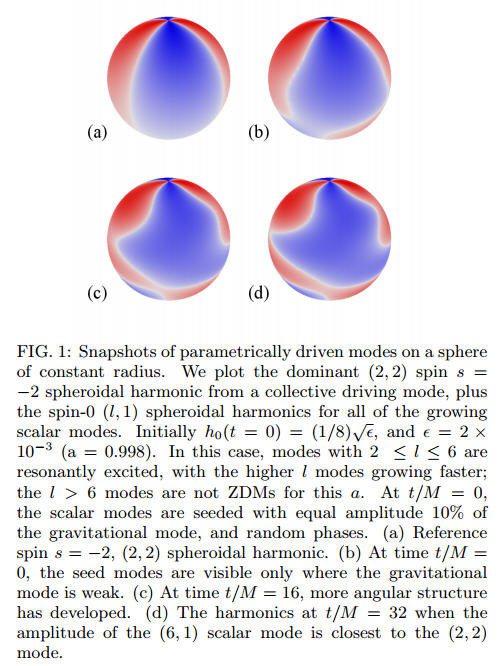If you’re flying in the vicinity of a black hole, seatbelts and a bumpy ride are really the least of your concerns, but we are in the world of the hypothetical, and the accepted wisdom among gravitational thinkers has been that spacetime cannot become turbulent.
An idea by the wizards at the Perimeter Institute is that such accepted hypothetical wisdom might be wrong.
The researchers followed this line of thought: Gravity might be able to behave as a fluid. One of the characteristic behaviors of fluids is turbulence – under certain conditions, fluids don’t move smoothly, they eddy and swirl.
Presto, let's put something on arXiv.
This gravity/fluids duality is not new but turbulent black holes are going to be treated with even more skepticism than the world of conjectural physics usually gets.
Why? Perimeter Faculty member Luis Lehner says, “There’s a conjecture in physics – the holographic conjecture – which says gravity can be described as a field theory,” he says. “And we also know that at high energies, field theories can be described with the mathematical tools we use to describe fluids. So it’s a two-step dance: gravity equals field theory, and field theory equals fluids, so gravity equals fields equals fluids. That’s called the gravity/fluids duality."
But gravity can't be turbulent. Gravity is described by a set of equations that are sufficiently different from fluid dynamics equations such that there would not be turbulence under any circumstances. Not even in a universe where math says time travel is possible.
“Either there was a problem with the duality and gravity really can’t be fully captured by a fluid description, or there was a new phenomenon in gravity and turbulent gravity really can exist,” Lehner.
Previous mathematical work at Perimeter and MIT has hinted that there could be turbulence around the non-realistic case of black holes confined in anti-de Sitter space. “There might be turbulence if you confine gravity in a box, essentially,” says Lehner. “The deeper question is whether this can happen in a realistic situation.”
The team decided to do a simulation of fast-spinning black holes, because a fluid-dynamics description of such holes hints that the spacetime around them is less viscous than the spacetime around other kinds of black holes. Low viscosity increases the chance of turbulence – think of the way water is more swirly than molasses.

Credit:
arXiv:1402.4859
The team also decided to think about non-linear perturbations of the black holes. Gravitational systems are rarely analyzed at this level of detail, as the equations are complex, but knowing that turbulence is fundamentally non-linear, the team decided a non-linear perturbation analysis would work. It's not like you can prove them wrong, really.
No surprise their analysis showed that spacetime did become turbulent.
“I was quite surprised,” says co-author Huan Yang, who studies general relativity. “I never believed in turbulent behavior in GR, and for good reason. No one had ever seen it in numerical simulations, even of dramatic things like binary black holes.”
If it is real, how did this behavior hide until now? “It was hidden because the analysis needed to see it has to go to non-linear orders,” says Yang. “People didn’t have enough motivation to do a non-linear study. But, this time, we knew what we were looking for. It gave us the motivation to do a more in-depth study. We had a target and we hit it.”
This is hypothetical, but it might not stay that way. Next-generation detectors might soon be able to detect gravitational waves – ripples in this gravitational “fluid” that result from big events like the collision of two black holes. If gravitation can be turbulent, then those ripples might be a bit different than previous models suggest. Knowing about these differences may make gravitational waves easier to spot. And, of course, actually detecting these differences would be direct evidence of gravitational turbulence.
“There are potential observational consequences of this discovery,” says Lehner. “LIGO or LISA or some future gravitational wave experiment may be able to detect them.”
Experimental physicists always love when theoreticians come up with something new and say it's their job to find it.
But if they can figure out black hole turbulence, maybe we can figure out the terrestrial kind. Talking about modeling nonlinear behavior is one thing, doing it is not so easy. To model it, they have to do linear in really small steps, which actually isn't nonlinear, it is just linear and things go crazy. Turbulence is one of the biggest unsolved mysteries in classical physics.
And if you can treat gravity like a fluid, why not treat fluids gravitationally?
“We’ve been stuck for over 500 years on achieving a full understanding of turbulence,” says Lehner. “This gravity/fluid correspondence tells us that there is a way to use gravitational tools and gravitational intuition to take a fresh look at turbulence. We may end up as stuck as we are in our standard approach, or we may end up shedding completely new light that helps the field go forward. It’s very exciting.”
Citation: Huan Yang, Aaron Zimmerman, Luis Lehner, 'Turbulent Black Holes', arXiv:1402.4859





Comments